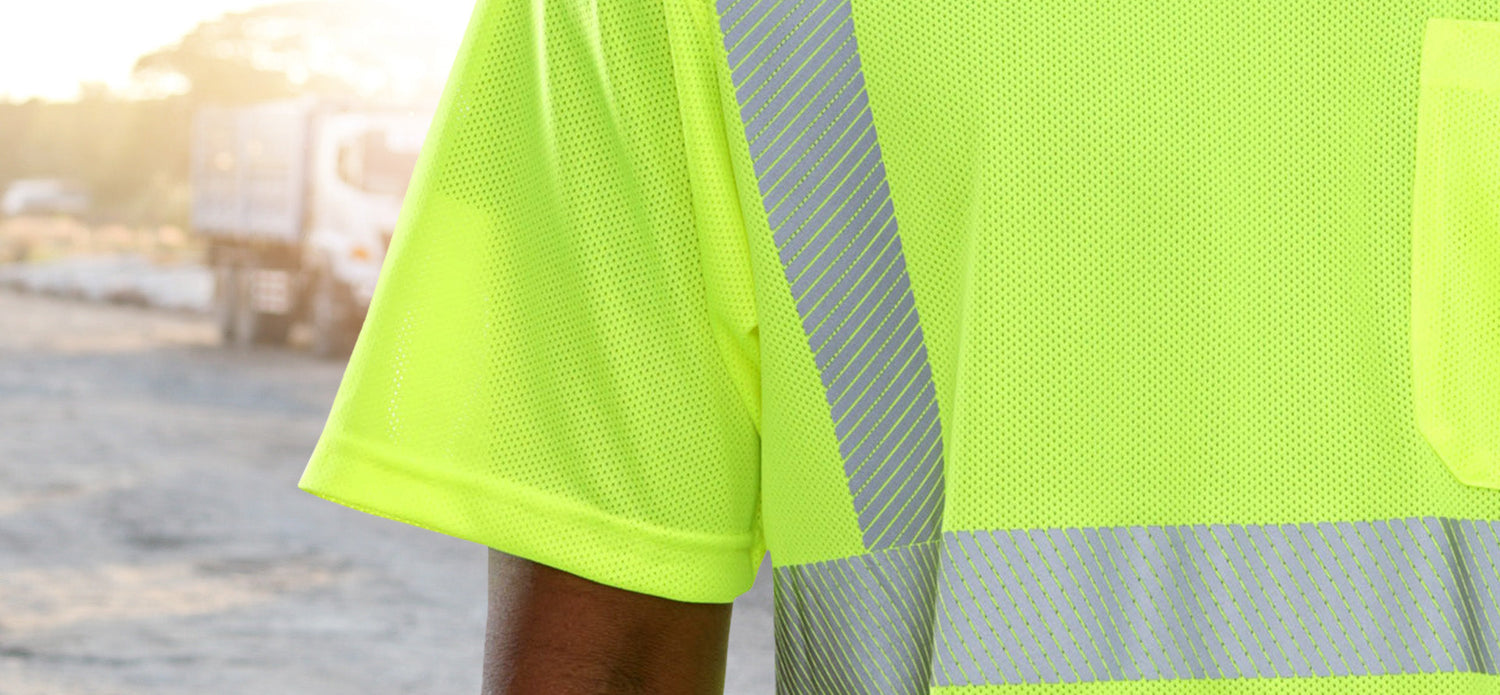As temperatures rise, you may be asking yourself, “How do I keep employees who wear hi-vis apparel comfortable and visible in the heat this summer?”
Heat exhaustion and heat stroke are serious worker safety concerns that must be taken into account. Each year, an average of 9,235 people are hospitalized due to heat and an average of 702 heat-related deaths occur each year, according to the Centers for Disease Control and Prevention.
Below are some things to consider when choosing the right fabric to keep your employees cool and visible this summer.
What fabrics are ANSI & ISEA compliant?
Since the purpose of hi-vis apparel is to keep employees safe and visible, we need to start by asking, “Which fabrics are ANSI & ISEA compliant?”
It may surprise you to learn that cotton does not pass the requirements set forth by the American National Standards Institute (ANSI) and the International Safety Equipment Association (ISEA) in regards to high visibility safety apparel standards. Hi-vis cotton fails after wash and exposure testing because the fibers do not absorb an adequate amount of the fluorescent color that is required for the background material.
While textile mills do manufacture a 50/50 (cotton to polyester ratio) that is often named “safety green” or “safety orange,” these garments do not meet ANSI and ISEA requirements, even with the addition of the appropriate retro reflective tapes. Therefore hi-vis cotton will not offer the level of protection required. As a result, Reflective Apparel does not offer any hi-vis cotton or cotton/polyester blends.
Polyester, which is a petroleum-based fiber, does maintain an ANSI and ISEA compliant-level of fluorescence. Before the fibers are extruded, they begin as small plastic chips that are then melted and extruded through a spinneret that creates the fibers. After this process, the dye color is chemically added as the material is spun. The color, whether orange or yellow, is uniform throughout each fiber, giving it the ability to maintain the hi-vis color and brightness for the life of the garment.
What if employees prefer the feel of cotton? Modern processes now allow for synthetic fibers to be woven in various textures to simulate the feel of cotton. For instance, our ANSI Class 2 Hi-Vis Lime Jersey Knit Tee has a cotton-like feel but is 100 percent polyester.
What hi-vis fabrics are most breathable?
The breathability of a fabric plays a significant role in keeping workers cool. The breathability of a fabric is defined as the ability of a fabric to allow perspiration to escape.
Beware of low-quality, thick polyester hi-vis fabrics that prevent body heat from releasing, which can lead to overheating. Instead look for high-quality polyester that has wicking properties that pull moisture away from the body. Brands such as Nike®, Under Armour® and WildSpark™ have revolutionized polyester with wicking, antimicrobial and reflective advancements. These improvements make modern polyester ideal for keeping workers cool and safe with ANSI & ISEA compliant tees and outerwear. Even cotton, which is known for its breathability, is not as cooling as these wicking polyesters. In fact, cotton fibers can hold water 24-27 times their own weight! So working outdoors, with rain, high humidity and excessive perspiration, workers are most comfortable and visible in high-quality, wicking hi-vis polyester.
Below are three examples of ANSI reflective tees made of high-quality polyester fabrics of three different weights.
103CTLM Hi-Vis Lime Micromesh Pocket Safety Shirt with Comfort Trim by 3MTM
This Hi-Vis Safety Shirt is ANSI Class 2 Compliant. Made with ultra lightweight 3.7oz Micromesh Polyester. The micromesh's breathability permits movement of air around the body, keeping you cool and comfortable. As a performance fabric, it wicks away moisture 3x faster than cotton. Our High Visibility Shirt is the longest wearing and lightest weight t-shirt on the market, featuring 75 wash certified reflective. In addition, the 3M™ Scotchlite™ Reflective Material – 5510 Comfort Trim adds extra comfort and does not buckle or rub like sewn on reflective tape.
342CTLB Safety Polo: HACCP Polo Shirt: Two-Tone Birdseye: Comfort Trim by 3MTM
This Hi-Vis Safety Polo Shirt is ANSI Class 2 Compliant. Made with lightweight 4.1oz Birdseye Knit Polyester. It feels butter soft on the inside, yet is work-wear durable. It features a rib knit collar and 3-snap placket for a professional appearance. Our High Visibility Polo Shirt wicks away moisture 3 times faster than cotton and is available in two-tone lime/black to help hide stains and workwear. In addition, the 3M™ Scotchlite™ Reflective Material – 5510 Comfort Trim adds extra comfort and does not buckle or rub like sewn on reflective tape.
101CTLM Hi-Vis Lime Jersey Knit Tee with 3M™ Scotchlite™ Comfort Trim
This High Visibility Safety Short Sleeve Shirt is ANSI Class 2 Compliant. Made with lightweight 6oz Jersey Knit Polyester, it has a cotton-like feel. The performance fabric wicks away moisture 3 times faster than cotton. In addition, the 3M™ Scotchlite™ Reflective Material 5510 Comfort Trim adds extra comfort and does not buckle or rub like sewn on reflective tape.
Bonus fact!
Polyester is good for cold weather too. Polyester is not just a hot-weather fabric. In fact, the wicking properties of performance polyester play a role in keeping workers warm during cold weather conditions. If moisture is trapped near the body, workers end up feeling cold, damp and uncomfortable. Even though you want to let moisture out, you do not want to let moisture, like rain or snow, in. Performance polyesters can be treated to be breathable, waterproof, windproof and reflective.
If you are not sure which fabric is right for your workforce, contact the Reflective Apparel team, and we will ensure your employees are both safe and comfortable.
866.998.2649
www.reflectiveapparel.com







